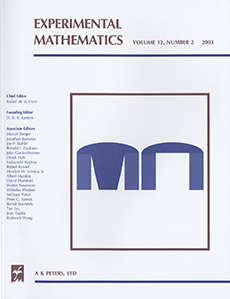Abstract
For quadratics with period-one negative continued fraction expansions,
X\theta =\frac{1}{ a-{\dfrac{\mathstrut 1}{a-{\dfrac{\mathstrut 1}{a- \cdots }}}}},
we show that the inhomogeneous Lagrange spectrum,
\bL (\theta) :=\bigl\{ \liminf\nolimits_{|n|\rightarrow \infty} |n|@\|n\theta -\gamma\| : \gamma \in \funnyR,\; \gamma \not\in \funnyZ+\theta \funnyZ\bigr\},
contains an inhomogeneous Hall's ray $[0,c(\theta)]$ with $$c(\theta)=\tfrac{1}{4}\bigl(1-O(a^{-1/2})\bigr)\hbox{.}
We describe gaps in the spectrum showing that this is essentially best possible. Pictures of computed spectra are included. Investigating such pictures led us to these results.
Citation
Christopher G. Pinner. Dan Wolczuk. "On the Inhomogeneous Hall's Ray of Period-One Quadratics." Experiment. Math. 10 (4) 487 - 496, 2001.
Information




